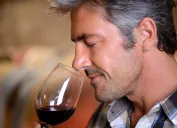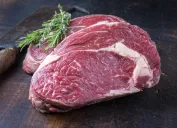
Some call it a happy dance, some people describe it more like a wiggle, but the phenomenon of dancing when eating something truly delicious isn't as strange or rare as it might seem.
If you're not sure what I'm talking about, though, I'll direct you to internet-famous toddlers like this little kid, who can't stop grooving to silence while she eats her grilled cheese.
If you already know what I'm talking about, you're in the illustrious company of other viral figures like this pup named Bond who even got an upbeat soundtrack for his happy food dance:
These dogs and little kids are the physical embodiment of irrepressible excitement, and we tend to think they're adorable—maybe in part because we recognize the impulse from our own behavior. Though this reaction hasn't been formally studied yet by the scientific community, there's a sizable number of people online asking themselves (and others) the same question: Why do we feel like dancing when we eat, even when there's no music?
The Theories
Is it because, when we're looking forward to something good, we aren't content with just commenting on how excited we are, and instead feel the need to release anticipation by doing a little dance or bounce? Does it begin when we're babies and toddlers, too young to accurately voice our enjoyment? Maybe we keep that mechanism as we grow older, as a way to express how much we love what we are eating and how good it tastes. Whatever the case, theories abound.
Professor Charles Spence, head of the Crossmodal Research Laboratory at Oxford University, has some ideas. He says that we can definitely consider "sensation transference from one perception/activity to another" when we think about this question. If you're listening to music while you eat, for example, generally speaking, "the more you like the music, the more you like the food eaten while listening to that music." By following that line of reasoning, "if one likes dancing then one's enjoyment of that activity might transfer to food." So maybe the little dance or wiggle we do is a way to appreciate the food even more; if you like to dance, in other words, indulging in that motion might heighten your enjoyment of the eating experience.
Other psychologists I reached out to told me "your guess is as good as mine," so here's my guess (based on existing research and a few hunches). At a very basic, chemical level, eating food gives a hit of dopamine, the neurotransmitter often referred to as the "chemical of reward," because it signals the anticipation of pleasure. (This lil' guy is also related to addiction, lust, and motivation; suffice it to say, it's complicated, and hasn't been fully figured out yet.) Finnish researchers have recently proven that eating food leads to a rush of endorphins, as well. Endorphins are another neurotransmitter that acts as the brain's natural painkiller, responsible for helping you cover over pain and discomfort.
So because of the release of dopamine and then endorphins, we connect eating food with feeling good. Dopamine is also a part of the process that gets us moving, so maybe it does double duty in this case. The joy of anticipating—and then tasting—that first delicious bite just might need a physical expression, thus linking it with movement. Dopamine can propel you to take action: Perhaps both to take another bite of whatever you're eating, and move your body to express how you're feeling.
Of course, dancing is also an activity that brings its own release of endorphins. As dance psychologist Dr. Peter Lovatt shared with The Telegraph, dancing is cathartic, since it connects with the emotional centers in the brain. That emotional release goes hand in hand with a release of endorphins that can be bigger than what is released during other types of exercise. So perhaps this is our body's way of looking for a double-whammy release of endorphins: The dopamine of anticipating a delicious bite combines with the endorphins of dance to give us a truly wonderful experience, however brief. And as Dr. Spence pointed out, the sensation transference from food to dance, and vice versa, could also help explain why these two activities seem to go hand in hand.
The (Maybe) Answer
Though it's been proven that both dancing and eating food release endorphins and dopamine, there have yet to be studies that firmly connect eating satisfying food with the desire to dance in your seat. There are still more questions than answers. Is the impulse to dance innate to only some people, or is it learned? Is it something you grow out of? Does it depend what kind of food you're eating, or the mood you're in beforehand?
Despite conjecture, we're no closer to a definitive answer, even though this phenomenon has appeared in everything from viral videos to old Snoopy cartoons. Snoopy's final question in the number "Suppertime" from You're a Good Man, Charlie Brown is apt—"What's wrong with making mealtime a joyous occasion?" he asks. Though the happy dance that comes with eating food is still something like a magical phenomenon that we do not yet have the tools to investigate, there's no reason to stop. Why shouldn't mealtime be a joyous occasion, in as many ways as possible? So when your taste buds commandeer your internal jukebox, at the very least, don't feel that you're alone. And hopefully, scientists will wiggle their way to an answer for this mystery someday soon. And for more amazing trivia, check out 50 Mind-Blowing Facts We Bet You Didn't Know.
To discover more amazing secrets about living your best life, click here to follow us on Instagram!





















